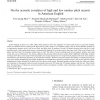Free Online Productivity Tools
i2Speak
i2Symbol
i2OCR
iTex2Img
iWeb2Print
iWeb2Shot
i2Type
iPdf2Split
iPdf2Merge
i2Bopomofo
i2Arabic
i2Style
i2Image
i2PDF
iLatex2Rtf
Sci2ools
SPEECH
2010
2010
On the acoustic correlates of high and low nuclear pitch accents in American English
Earlier findings in Shue et al. (2007, 2008) raised questions about the alignment of nuclear pitch accents in American English, which are addressed here by eliciting both high and low pitch accents in two different target words in several different positions in a single-phrase utterance (early, late but not final, and final) from 20 speakers (10 male, 10 female). Results show that the F0 peak associated with a high nuclear pitch accent is systematically displaced to an earlier point in the target word if that word is final in the phrase and thus bears the boundary-related tones as well. This effect of tonal crowding holds across speakers, genders and target words, but was not observed for low accents, adding to the growing evidence that low targets behave differently from highs. Analysis of energy shows that, across target words and genders, the average energy level of a target word is greatest at the start of an utterance and decreases with increasing proximity to the utteran...
| Added | 30 Jan 2011 |
| Updated | 30 Jan 2011 |
| Type | Journal |
| Year | 2010 |
| Where | SPEECH |
| Authors | Yen-Liang Shue, Stefanie Shattuck-Hufnagel, Markus Iseli, Sun-Ah Jun, Nanette Veilleux, Abeer Alwan |
Comments (0)

